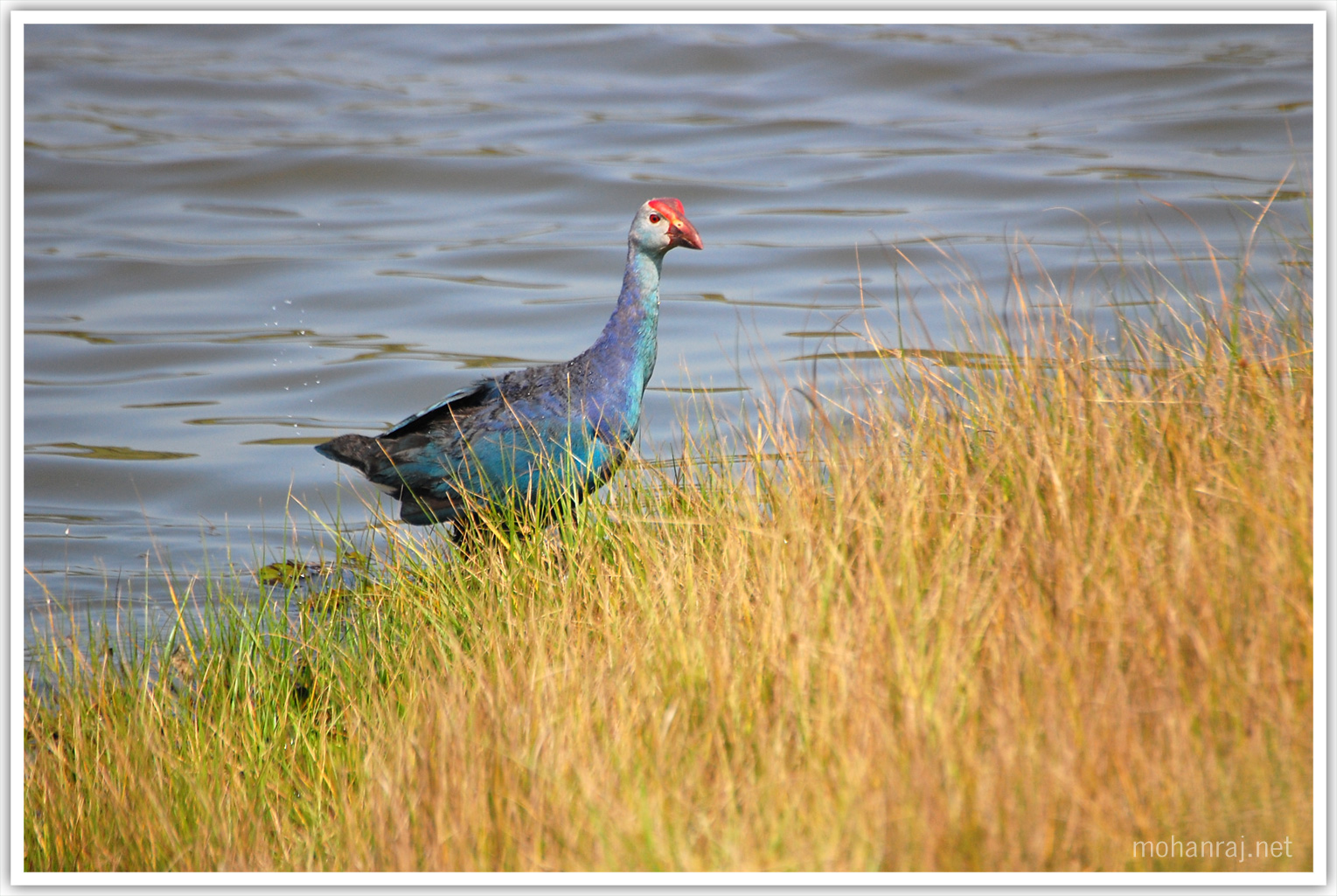- Purple Swamphen
Taxobox
name = Purple Swamphen
status = LC | status_system = IUCN3.1

image_caption = "P. p. poliocephalus" - Thommana, Irinjalakuda, Kerala, India
regnum =Animal ia
phylum = Chordata
classis = Aves
ordo =Gruiformes
familia =Rallidae
genus = "Porphyrio "
species = "P. porphyrio"
binomial = "Porphyrio porphyrio"
binomial_authority = Linnaeus, 1758The Purple Swamphen ("Porphyrio porphyrio"), also known as the African Purple Swamphen or Purple Moorhen or Purple Gallinule or Purple Coot , is a large bird in the family
Rallidae . From its name in French, "talève sultane", it is also sometimes known as the Sultana Bird. It should not be confused with theAmerican Purple Gallinule , "Porphyrio martinica". The common name in New Zealand, used for "P. p. melanotus" isPūkeko , and is derived from the Māori name for the species.Taxonomy and physical description
There are six or more subspecies of the Purple Swamphen, depending on the authority, which differ mainly in the
plumage colours. The races are:
* "P. p. porphyrio" in Europe
* "P. p. madagascariensis" inAfrica
* "P. p. poliocephalus" in tropicalAsia
* "P. p. melanotus" in much ofAustralasia
* "P. p. indicus" inIndonesia
* "P. p. pulverulentis" in thePhilippines .European birds are overall purple-blue, African and south Asian birds have a green back, and Australasian and Indonesian birds have black backs and heads. The Philippines subspecies is pale blue with a brown back. This chicken-sized bird, with its huge feet, bright plumage and red bill and frontal shield is unmistakable in its native range.Some authorities separate various subspecies as full species, for example "P. p. madagascariensis" is split by Sinclair "et al" as African Purple Swamphen, "P. madagascariensis".
Purple Swamphens are considered to be the ancestors of several island species including the
extinct Lord Howe Swamphen and two species ofTakahē inNew Zealand . The Purple Swamphen itself, deriving from a later self-introduction, is a native of New Zealand, where it is called the Pūkeko. Its range is thought to have expanded there after the arrival of humans as the numbers of Takahē declined to near-extinction levels.Reproduction
The breeding habitat is warm reed beds across southernmost Europe, Africa, tropical Asia, and Australasia. The male has an elaborate courtship display,holding water weeds in his bill and bowing to the female with loud chuckles.cite book
last = Ali
first = Salim
authorlink=Salim Ali (ornithologist)
coauthors = JC Daniel
title = The book of Indian Birds, Twelfth Centenary edition
year = 1983
publisher=Bombay Natural History Society /Oxford University Press
address = New Delhi]Pairs nest in a large pad of interwoven reed flags, etc., on a mass of floating debris or amongst matted reeds slightly above water level in swamps, clumps of rushes in paddocks or long unkempt grass. Multiple females lay in the one nest and share the incubation duties, the nest is composed of grass or similar materials. Each bird can lay 3-6 speckled eggs - pale yellowish stone to reddish buff, blotched and spotted with reddish brown. A communal nest may contain up to 12 eggs, incubation period is 24 days.
Ecology and behavior
The Purple Swamphen prefers wet areas with high rainfall, swamps, lake edges and damp pastures. The birds often live in pairs and larger communities. It clambers through the reeds, eating the tender shoots and vegetable-like matter, they have been known to feed on
invertebrates (like snails) and to rob eggs from nests and also eat ducklings. Sometimes they eat small fishes as well. They will often use one foot to bring food to their mouth rather than eat it on the ground. Where they are not persecuted they can become tame and be readily seen in towns and cities.This species has a very loud explosive call, also described as a "raucous high-pitched screech, with a subdued musical "tuk-tuk". It is particularlynoisy during the breeding season. In spite of being clumsy in flight it can fly long distances, and it is also a good swimmer, especially for a bird without webbed feet.
Roman times
Evidence from
Pliny the Elder and other sources shows that the Romans kept Purple Swamphens as decorative birds at large villas and expensive houses. They were regarded as noble birds and were among the few birds that Romans did not eat.Escapes and introductions
Purple Swamphen is occasionally recorded as an escape from captivity in Britain and elsewhere. An introduced population exists in
Florida , though state wildlife biologists are trying to eradicate the birds. SeePurple Swamphens in North America .Gallery
References
*
* Leo, Roger (2006). 'Shorebirds in Art: Looking at history through the purple swamphen'. "Sanctuary: The Journal of the Massachusetts Audubon Society", Summer 2006, 45 (4):18-19
* Moon, Geoff (1994) "The Reed field guide to New Zealand birds", ISBN -X
* Taylor, Barry and Van Perlo, Ber "Rails" (a volume in theHelm Identification Guides series) ISBN
*Ian Sinclair, Phil Hockey and Warwick Tarboton, "SASOL Birds of Southern Africa" (Struik 2002) ISBN
* Mike Clary, "State aims to eradicate exotic purple swamphens in wetlands," South Florida Sun-Sentinel, Sept. 8 2007External links
* [http://ibc.hbw.com/ibc/phtml/especie.phtml?idEspecie=1301 Purple Swamphen videos] on the Internet Bird Collection
Wikimedia Foundation. 2010.
